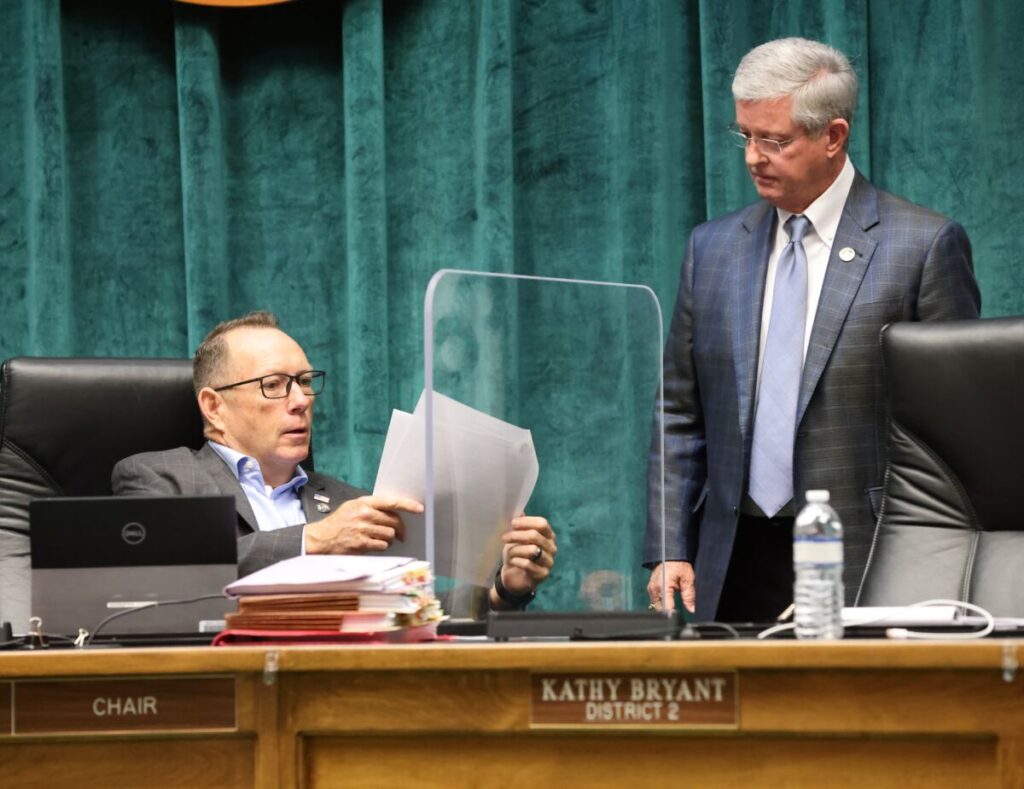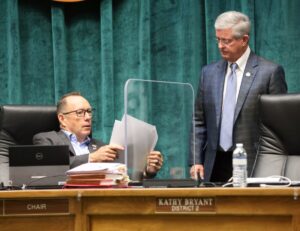County plans to spend $71 Million

Chair Jeff Gold, left, talks with Commissioner Craig Curry before the start of a Marion County Commission meeting in Ocala, Fla. on Tuesday, March 16, 2021. [Bruce Ackerman/Ocala Gazette] 2021.

Chair Jeff Gold, left, talks with Commissioner Craig Curry before the start of a Marion County Commission meeting in Ocala, Fla. on Tuesday, March 16, 2021. [Bruce Ackerman/Ocala Gazette] 2021.
The Marion County Board of County Commissioners (MCBOCC) have been discussing how to allocate use of the $71,000,000 received from the federal government under the American Rescue Plan Act (ARPA).
President Biden signed ARPA into law on March 11, 2021. The U.S. Treasury began distributing $350 billion of ARPA funds on May 11, with half being released in 2021 and the other half set to be released in 2022.
Many of the proposed projects are infrastructure-related, something County Administrator Mounir Bouyounes says is necessary.
“Marion County is a hot spot, especially for the retirement community. It’s either we plan for it and be ahead of the curve, or we sit back, and growth will overtake everything we’re doing. And we’ve got to be smart about how we do it.”
Boyounes also indicated that infrastructure projects are vital to expanding the type of businesses that develop and relocate into Marion County.
“Since 2014, we have been looking at ‘how do we diversify our economy, so if one sector of the economy goes down, we don’t shut down the whole county and be in the same situation we were in in 2008.’ I remember, [in] 2008 through 2012, I think the unemployment was at like 15 percent. When the housing market went down, everything went down with it. And that’s what happened when you are [a] single industry type economy.”
But with more people and businesses, comes the need for better infrastructure.
August ARPA presentation
During the Aug. 17 MCBOCC meeting, Bouyounes informed the board that half of Marion County’s allotment of ARPA funds, or $35,504,717, had already been received by the county.
Angel Roussel, Assistant County Administrator for Public and Environmental Services, briefed the board on the ARPA funds and the conditions the federal government placed on their usage.
The funds can only be spent to support public health expenditures, address negative economic impacts caused by the public health emergency, replace lost public sector revenue, provide premium pay for essential workers, or to invest in water, sewer, and broadband infrastructure.
The funds have deadlines attached to them as well.
Roussel noted that the board must “obligate” the ARPA funds by Dec. 31, 2024, and spent by Dec. 31, 2026. Unused money would need to be returned to the federal government.
During his presentation, Roussel broke the funding down into five proposed projects.
First, a broadband feasibility study, with a proposed cost of $500,000, with the intention of identifying any un- or underserved areas of the county. Roussel expressed hope that any unused funds be used to address “low hanging fruit” identified in the study.
Second, an extension of water services in the vicinity of the Florida State Fire College and North Marion Middle School with a cost of $7 million. The proposal highlighted the need for an extension of approximately 50,000 linear feet, or 9.5 miles, to service this area with water, according to Roussel’s presentation.
The need for this extension is due to a PFAS contamination, reported on separately in this issue.
Third, a general water line extension program was proposed with a $5 million price tag. The goal to assist with expansions to short and long-line projects. Roussel proposed that the board, through either a resolution or an ordinance, establish how the funds were to be used and whose projects would be eligible, on a first come, first serve basis, until funds are depleted. Any funds not used would be reassigned to other projects.
Fourth, a $10 million investment to increase water service to Marion Oaks, designed to complete water mains north and east of Hwy 484.
And finally, the largest project considered in Roussel’s proposal was one with a scalable cost of $30 to $60 million to increase both water and sewer to Silver Springs Shores.
The project broke areas in Silver Springs Shores down into three phases of 500 lots each with each phase carrying a cost of about $15 million.
Roussel added that grant funding might be available to mitigate the cost to the county.
Bryant asked how many of the Silver Springs Shore lots were built out and how many were vacant, and Roussel responded he would need to verify the answer and return with that information.
Zalak inquired about the residents of Silver Springs Shores who already had a well and septic system on their property, to which Roussel replied there may be grant funding that could help residents switch from septic to sewer service. However, Roussel clarified that portions of the ARPA funding could also be used to refund those who recently installed septic tanks.
After Roussel’s Aug. 17 presentation, there was a motion by Vice Chair Zalak, which was seconded by Chairman Gold, to approve all the county projects except the Lowell drinking water project since the land was owned by the state. All five commissioners voted to approve the motion.
October 5 ARPA Update Presentation
At the Oct. 5 MCBOCC meeting, Roussel updated the board on the progress and status of the ARPA-funded projects as well as proposed a new project for consideration.
Roussel revisited the water project to address the contamination around the Florida State Fire College, updating the amount of people who would be impacted.
In addition to the 30 households who had been impacted, there were also other residents to consider at the state prisons: Lowell Correctional Facility, its annex, Marion Correctional, and the Reception Center with a total population of 5,515 people.
In addition, Roussel pointed out that the Florida State Fire College hosts 7,000 students a year and North Marion Middle School hosts 700 students every year.
Roussel noted there were 78 contaminated wells, per 2019 Florida Department of Health data. More information on PFAS can be found here.
On the Silver Springs Shores water and sewer project, Roussel clarified how many of the sites were improved and vacant and added a fourth phase to the project.
For phase one, 50 percent of the sites are improved while 55 percent are in phase two, 49 percent are in phase three, and 66 percent are in phase four.
Roussel also offered a 5-year, $2.4 million project proposal for an area identified as a “strategic area to encourage infill,” located “north of SR 200, west of the city of Ocala, south of Calesa (a planned community), and east of On Top of the World,” for the board’s consideration.
For this new proposed project, road and trail improvements are ultimately planned as well as a park. The initial stages of the project are water and sewer improvements, including a $900,000 water line extension, a $980,000 sewer line extension, $420,000 for a new lift station, and $100,000 to decommission current facilities.
Bouyounes said, “We identified that area to be an infill-type development. And we talked about when we have infill-type areas to be developed, what do we need to do? We first need to make sure that we have all the infrastructure in place. If we want to encourage developers to start looking at those areas, we need to have the infrastructure in place, and that’s one area that with running that line, it will give us the opportunity to assist developing that area.”
The new proposed plan would be funded with $2.4 million that was taken from the $48.5 million currently allocated to the Silver Springs Shores water and sewer project, leaving $46.1 million remaining for the Shores project.
Roussel then detailed the multiple unsolicited community requests the county has received since being awarded ARPA funds. He broke the requests down into three categories: public agencies, business initiatives, and not-for-profit requests.
The lone public agency request was for $2 million from the College of Central Florida (CF) for their new proposed Health Science Technology Education Center. The lone business initiative request was for $2.5 million from the CEP to help fund new health-related business initiatives.
There were three not-for-profit requests. The Community Foundation asked for $8.4 million to help fund projects that addressed multiple community needs. The Phoenix House asked for $2.5 million to be used for staff and a new health facility. Finally, Community Services asked for $8 million to help with unfunded requests.
After some comments from the board and remarks by CF President Dr. James Henningsen, the board heard from Frank Mason, a partner with Carr Riggs Ingram, a national CPA and advisory firm, who confirmed the projects would qualify for APRA funding under the healthcare response and employment opportunities categories.
After the presentation and discussion, there was a consensus to reduce the Shores project by $2.4 million and allocate it to the new project proposal at SR 200 and 60th Ave.
Also, there was consensus to contribute $2 million to fund CF’s request and set aside $1 million for the CEP to help fund new health-related business initiatives.
The board directed staff to, among other things, draft an agreement with the College of Central Florida to allow two years to complete the Health Science Technology Education Center or the money would be reallocated.
The board also invited the community services department and the Community Foundation to present their plans for projects to be funded with the remaining $4 million during the Dec. 7, 2021, board meeting.
Latest update
According to an Oct. 15 email from Stacie Causey, a spokeswoman for the county, the board has currently directed use of ARPA funds for the following projects:
- $46,100,000 Silver Springs Shores water and sewer service
- $10,000,000 Marion Oaks water service
- $5,000,000 General water main extension project
- $4,000,000 To be determined
- $2,400,000 State Road 200/60th Ave. water service project
- $2,000,000 College of Central Florida nursing facility
- $1,000,000 New, health-related business initiatives
- $500,000 Broadband feasibility analysis study
Bouyounes says receiving funds such as ARPA and the Penny Sales Tax are extremely helpful when it comes to funding needed projects.
“The sales tax was huge. It helped us tremendously and we have been able to start getting things where they need to be, but there is a lot more [needed] to be able to meet the future demand.”
He said that projects will always be there, regardless of what the source of funding is.
“The needs that we have identified, whether it’s water and sewer, or transportation, […] outweigh any of those additional funding sources that we are receiving, or we may receive. So, we are always on the lookout if we have any additional money coming in. And those projects would qualify for that money.”
Info about how the county allocated use of the Penny Sales Tax can be found here and here.





